As the final matchday of the Champions League group stage approached us, there were many teams who were still battling it out for that final spot to advance into the knockout rounds. While there were groups who already decided two names who continued to move on, several groups were left undecided, not until the final whistle was blown. Group H was one of the groups that had a similar scenario since the difference between the top three teams was only two points.
Group leader Ajax Amsterdam were the team who had more advantages since they held the pole and registered a considerable goal difference. Furthermore, they also went on a decent run in the Eredivisie after an eight-goal draw against Chelsea before that streak was stopped by their 1-0 lost over Willem II. The visitor, Valencia CF, enjoyed a similar thing with three wins over the last four matches in La Liga. Furthermore, their 2-2 draw against Chelsea kept them in the race as a win over Ajax was what they needed to qualify for the next round.
And the Spanish club did exactly that with Rodrigo Moreno’s goal inside the first half sealed the vital three points for Valencia. This tactical analysis will provide an analysis of Valencia’s 1-0 win over Ajax. Meanwhile, using statistics, we will point out the standout tactical points of both Erik ten Haag’s tactics and Albert Celades’ tactics.
Lineups
With the advantage of being the home side in this match, ten Haag lined his side up in a familiar 4-2-3-1 formation which saw André Onana started in goal. Since both wingers David Neres and Zakaria Labyad both missed out through knee problems, the Dutch manager opted to use Hakim Ziyech and youngster Noa Lang to provide width for the team. They were supported by two dynamic wing-backs who played a key role in last season’s heroic run in Nicolás Tagliafico and Noussair Mazraoui.
Besides from the absences from both wingers and Quincy Promes, ten Haag welcomed back into his side the service of Daley Blind and Joël Veltman as they paired up with each other at the heart of the team’s defence. Klass-Jan Huntelaar was expected to start as the Dutch veteran could lend a hand solving Ajax’s problem inside the final third. Eventually, Dušan Tadić remained in the role of a false nine along with receiving support from attacking midfielder Donny van de Beek.
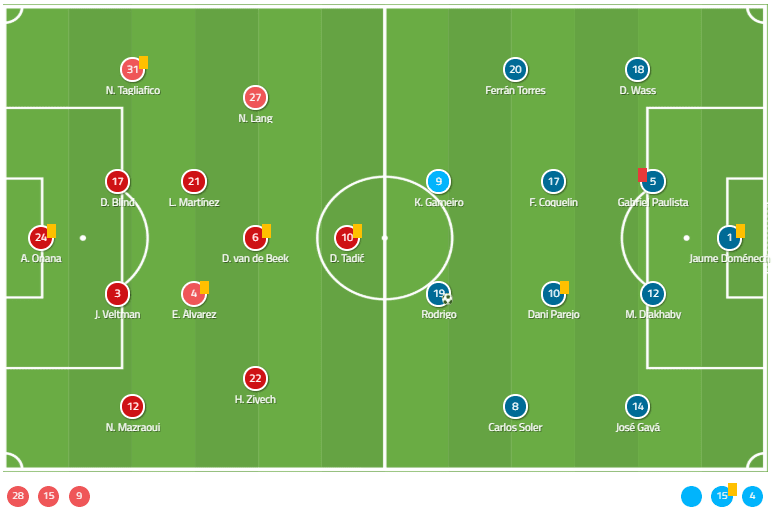
On the opposite side, Celades also used the familiar 4-4-2 formation for his Valencia side in their trip to the capital city of the Netherlands. Among the hefty injury list that they had before the match, one of the major absences from the squad list was Jasper Cillessen as the former Barcelona goalkeeper didn’t recover on time from the injury he faced against Levante. Instead, Jaume Doménech was chosen to be the team’s number one for this match as he received the cover from centre-backs Gabriel Paulista and Mouctar Diakhaby.
Another two players who also missed out from the squad list were Gonçalo Guedes and Geoffrey Kondogbia as they remained on the treatment list. At the same time, they welcomed back the service of Ezequiel Garay and Jaume Costa, but there was only Costa who eventually made the squad as he was registered among the substitutes.
Valencia’s defensive strategies
Just a few days before the start of the group stage, it was announced that Celades would replace Marcelino as the team’s manager throughout the campaign. Rather than choosing and adapting his philosophies and principles to the squad, he opted to keep the tactics that brought the success for the side last season.
One of the tactical principles that both Marcelino and Celades used for the team was creating a disciplined 4-4-2 defensive shape whenever they were out of possession. The side weren’t keen on defending narrowly as they aimed to stretch the defensive line out wide to handle at best both Ajax’s wing-backs and strikers. As mentioned, came along with this structure was the requirement to play with discipline. If a defender decided to step out of the line, he would create spaces for any Ajax attackers to move in.
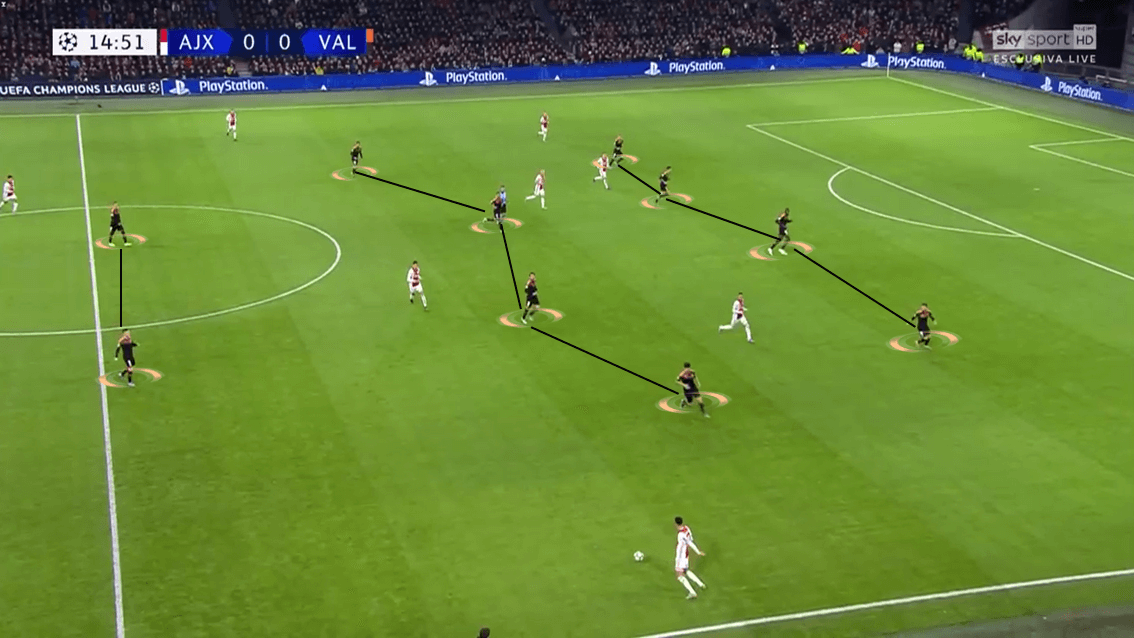
At the same time, they would keep the distance between the lines as narrow as possible. Celades wanted his players to eliminate every possible attack that could come from the spaces between the lines. With Ajax attempted to play in between the lines on many occasions, this strategy was crucial in keeping the Eredivisie champion from reaching Jaume Doménech’s goal.
While they didn’t opt to stay narrow and occupied the central area only, it was still important for them to stretch a bit wide and filled in both half-spaces. Still, that invited Ajax wide players to join the attack. In that case, the players would follow the ball and shift their shape with it. This was an intentional decision as Ajax occasionally found themselves on the back foot in terms of crossing into the box. Throughout the game, they registered thirty crosses but could only complete seven of them.
The reason that helped them kept Tagliafico and Mazraoui quiet for the majority of the time was the speed they put on during the shifting process. In the shot below, notice how the visitor managed to create an overload on Ajax’s left-hand side with the involvement of at least seven players. The nearest four players to the ball would form a pressing block and attempted to block every possible passing lane of the ball carrier. They aimed to force him to make a back pass that also allowed Valencia players to retreat to their defensive shape and restarted the press.
Also, that pressing block would take on the responsibility of closing down unoccupied gaps around the 16-yard box, which prevented any smart movements coming from the opposition’s attackers. Another interesting point that also needed to be taken into account was the players’ body orientation as it played somewhat a crucial role in their defensive tactics. Notice van de Beek (#6), who positioned himself in free space and would be ready to receive the ball from the ball carrier. Amid the fact that in reality, the ball carrier had been suffocated and wasn’t able to register any pass. But if that scenario happened in the opposite way and a pass would be made to the attacking midfielder, there would be no chance for him to progress the ball into the box even if Mazraoui offered to pick up the ball as Diakhaby and Parejo were ready to close him down.
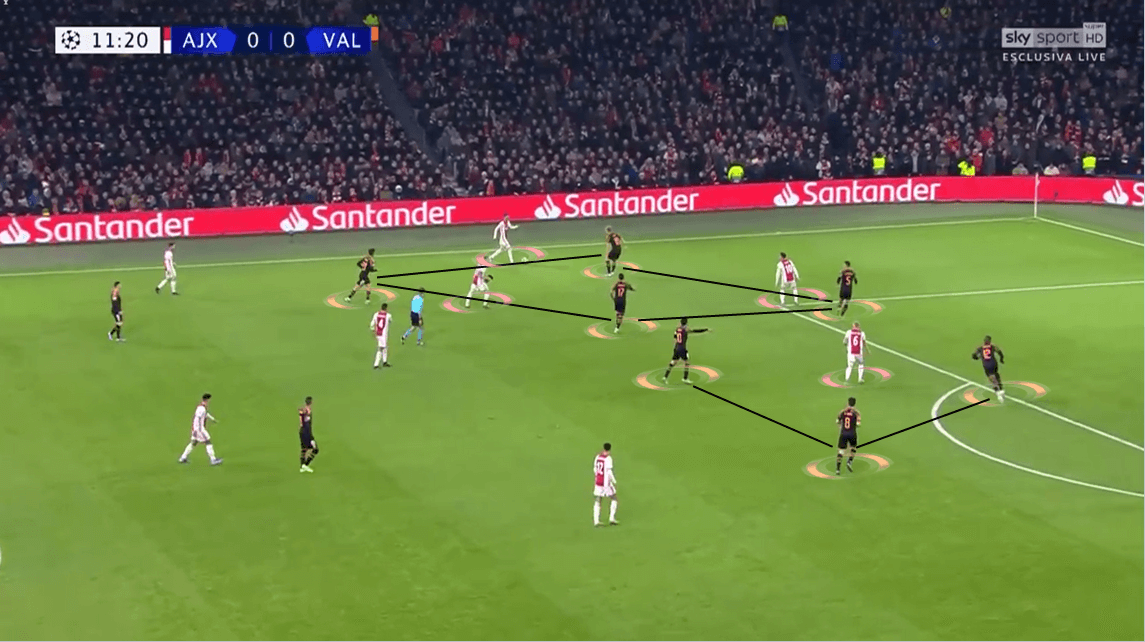
Up front, Valencia were also ready to increase the pressure on Ajax’s defenders when they played out from the back. Combined with the man-marking oriented system, it had proved its efficiency on some occasions. Rodrigo and Gameiro were always ready to press and recover the ball inside the opposition’s half. If Blind or Veltman managed to move the ball out wide, either Carlos Soler or Ferrán Torres would step out of the shape to provide support for the strikers.
With them not attempted to press aggressively on several occasions, it was viable for the players to have a good perspective on the situation and make a decision on should they came close to the ball carrier and tackle him or stayed with their teammates and waited for another opportunity. Besides from the four attackers who involved in the pressing process, both central midfielders in Dani Parejo and Francis Coquelin were also willing to push higher up the pitch to prevent Ajax’s double pivot from joining the build-up process.
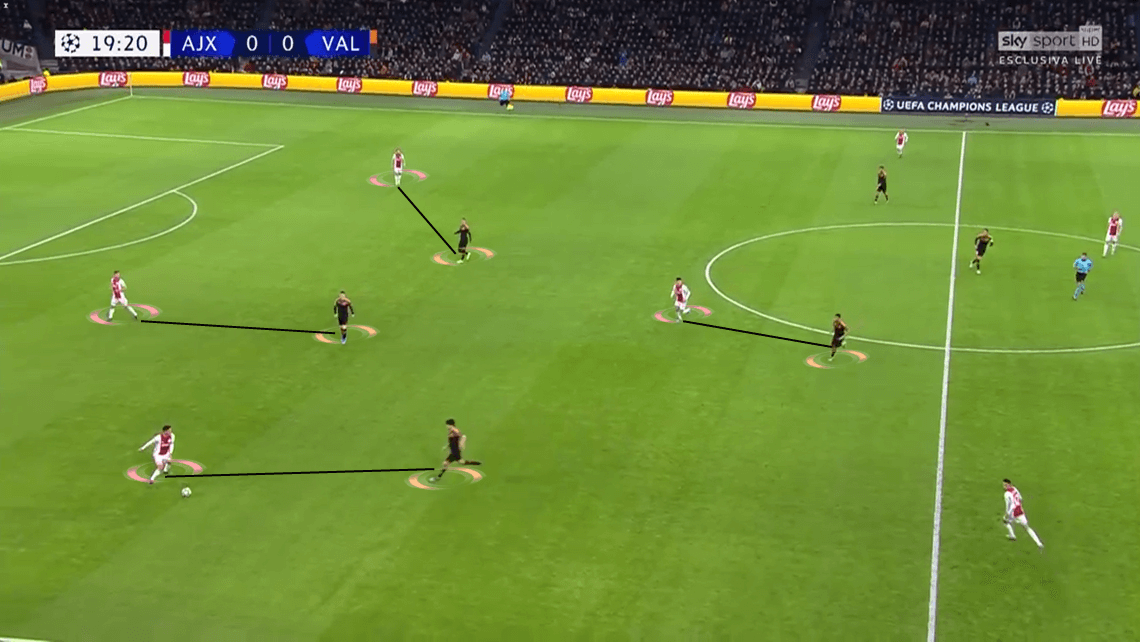
How did the winning goal come for Valencia?
When they were on possession, Valencia players put an emphasis on building their attacks from the back-line. In Gabriel and Diakhaby, they had two ball-playing defenders who were comfortable in recycling possession and progressed the ball up the pitch through their passes. Indeed, as this was backed by the number of passes that they made during the match. With 24 and twenty passes being made respectively, those records weren’t too bad at all.
Furthermore, since they also received the support from both central midfielders, the pressure of linking up the team’s passing block inside their half with the attackers up front wasn’t being put heavily on them. Considering Coquelin and Parejo were the two players who respectively topped the board for being the most accurate passers, it is understandable not to see Gabriel and Diakhaby making too many long passes up front. As the team’s main creative source, Parejo was responsible for creating smart passes that put the attackers into a good position for an attacking chance.
But surprisingly, Parejo was not the player who finished top of the list for the number of passes being made in the game. That honour belonged to Rodrigo and José Gayà, whose records stood at 31 passes. More specifically, Gayà’s record indicated an interesting trend in both full-backs being involved in the build-up process. This gained them the advantage in numbers that proved to be useful in bypassing the pressure from Ajax’s attackers.
Besides from involving in the team’s build-up, Gayà could also venture forward with the ball and made crosses for the strikers inside the box. When either full-back reached the final third, they could play one-two passes with Ferrán or Soler. It would help them bypass the press that came from Ajax’s defenders and allowed them to enter the 16-yard box.
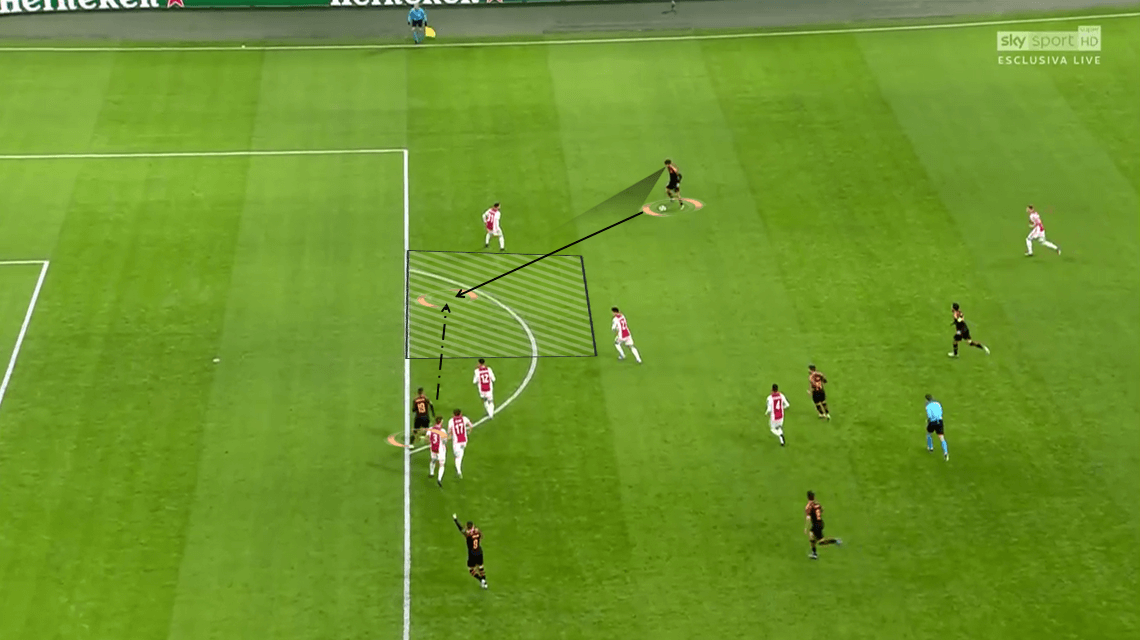
Still, that wasn’t the way how Valencia’s winning goal came for them amid the fact that it was progressed down the left-hand side. The Spaniard left-back turned inverted after Gameiro opened up the left half-space by drifting wide and received the ball from Soler.
With the opposition’s defenders quickly enough to overload the left side of the box, he had to dribble centrally and found Ferrán on the opposite side. But it was Rodrigo’s movement that really caught the eye. Starting from an offside position, he noticed the gap in front of them that was unoccupied and immediately acted to have the head start. This allowed Ferrán, who was also looking for a potential receiver, to connect with him for a through ball and set him up in a great position to score.
Another method that Valencia also used to find goals was from direct passes. In this match, they tended to make long passes and their total long pass share percentage was 16%, 6% more than Ajax’s record. As they only held 39% of ball possession, they didn’t have much chance to execute their plan and it seemed like long ball was their best option to progress the ball up the pitch. One advantage that could be seen from this style of play is that Valencia have shortened the build-up time. Valencia had pacey players in Ferrán and Rodrigo to support this style of play, and they also liked to keep the ball on one side. In the meantime, the players on the opposite side would jog towards the final third and waited to pick up the clearance from the opposition’s defenders.
Ajax’s style of play
On occasions where Valencia’s press was bypassed, the visitor would form their defensive shape inside their half and allowed Ajax to have more time on the ball during their build-up process and formed the three-man build-up, which was their preferred build-up shape. One of the pivots would drop deep and pushed Veltman into the middle. At the same time, the other pivot shifted centrally and created two passing triangles inside the middle third.
Another setup that they also went with was creating a passing block inside their half with both Edson Álvarez and Lisandro Martínez held onto their positions as pivots
. When the attackers sit on the shoulders of Valencia’s defenders, the wing-backs pushed high up the pitch and willing to attack the wide spaces. Their high positioning combined with the midfield line of four forced the opponent to track back and retreated to inside the box.
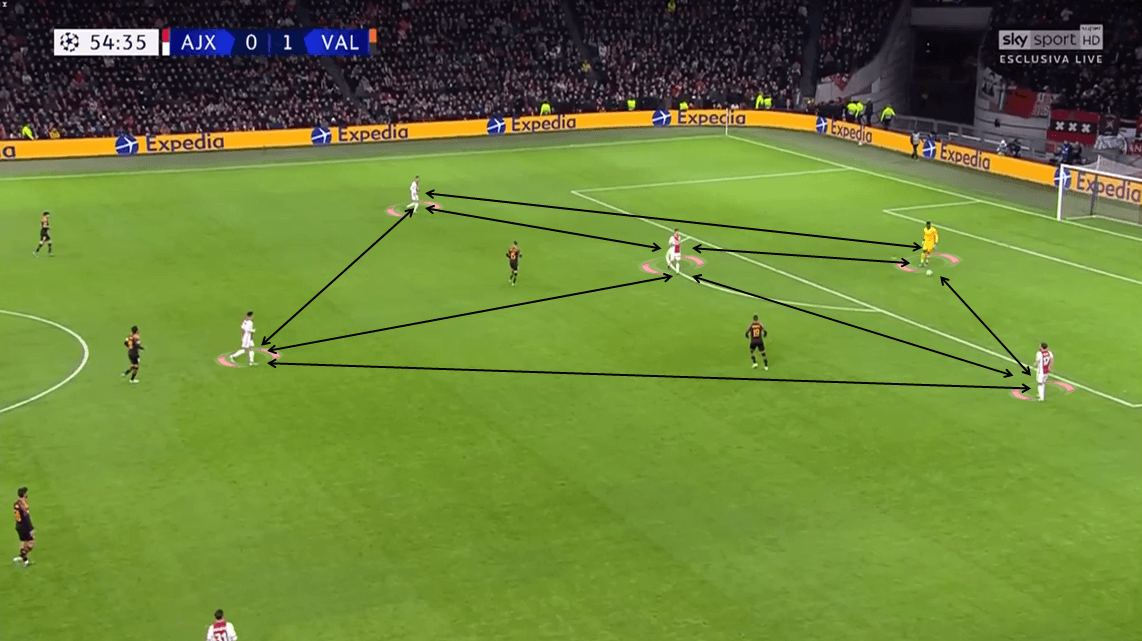
Since they had the chance to position themselves higher up the pitch and more time to circulate the ball around the passing block, it was not a surprise when they were the better team in terms of ball possession. As usual, from his position, Tadić would drop deep to create the front four alongside three attacking midfielders since he occupied the role of a false nine.
This gave the ball carrier more options to aim his passes towards and recycled possession at the same time. Around the Serbian attacker were van de Beek and Ziyech, two of Ajax’s creative players who could create space through their movements. Also, it is worth mentioning that Tadić and van de Beek usually switched position with each other. Whenever a player came deep to pick up the ball and brought their teammates into play, the other one would vacate the space being left behind.
Still, against Valencia’s defensive juggernaut, they faced troubles bypassing it as it was hard for them to get the ball into the final third. Although it was viable for Ajax to control possession inside the opposition’s half, the possible passing lanes that headed into the final third were all closed down by the discipline of Valencia’s players.
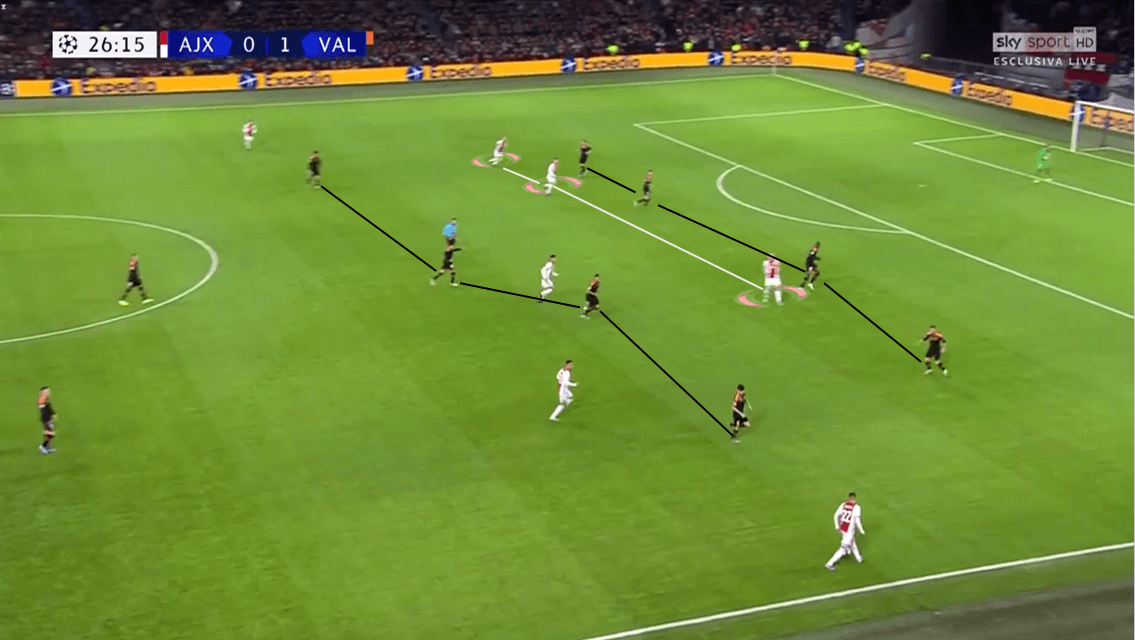
Since the central area was overloaded during most of the time, Ajax players had no choice but to turn towards the option of attacking down both flanks. Not only they adapted the position interchanging strategy constantly inside the central area, but it was also adapted inside the scenarios where they made the most of the abilities of the wide players.
As the wing-backs overlapped, the wingers would tuck inside and occupied the half-spaces. There were scenarios that the opposite thing happened, in which the wing-backs turned inverted to occupy the half-spaces and the wingers drifted wide. By doing so, Ajax players were attempted to stretch the opposition’s defensive structure and utilised spaces in between the defenders.
Besides from relying on crosses that being made into the box, Ajax wide players also attempted to try a new strategy since they acknowledged the aerial threat of Valencia’s centre-backs. With either the wing-back or winger got the ball to the edge of the final third, they would receive support from the other one. Using a one-two pass, it was viable for the ball carrier to reach the byline and made a cutback cross to the late arrivals. It was not much of an efficient strategy since most of those situations weren’t able to lead to a chance for Ajax players.
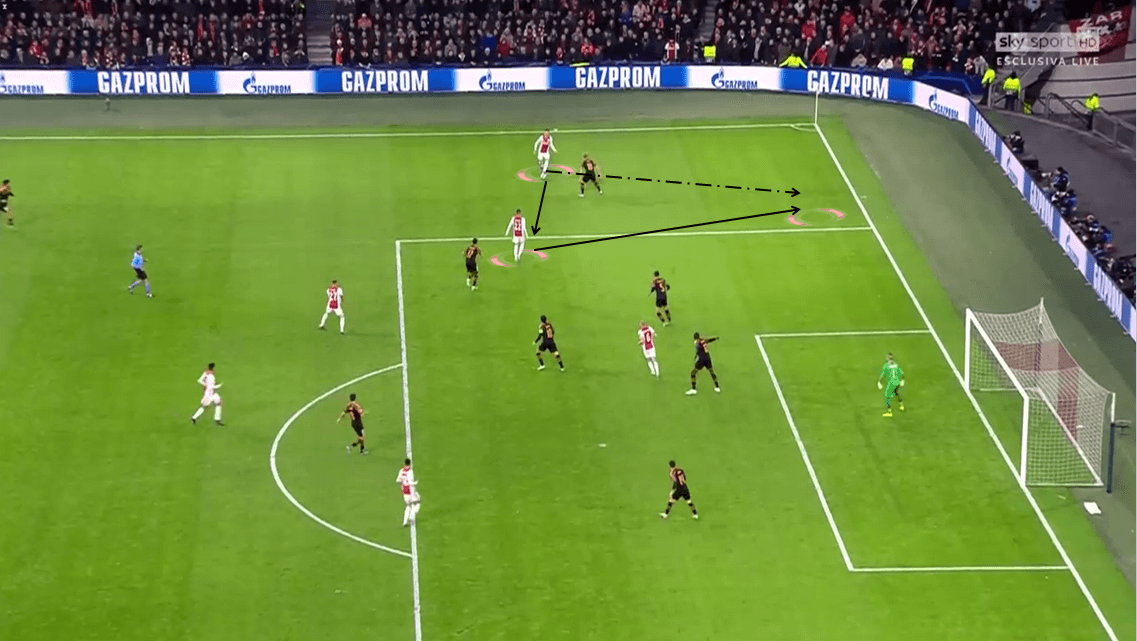
In that case, another attacking method was also deployed in order to help the attackers to reach Doménech’s goal in a quicker fashion. Directly from the build-up process, the centre-backs were encouraged to make long passes towards the edge of the final third while allowing the attackers to break into the gaps in between Valencia defenders.
Statistically speaking, Blind was the player who registered the most long-ranged passes among the players of both teams. With twelve long passes completed in a total of nineteen, it was an overwhelmed number but it was understandable since the former Manchester United player was deployed as a ball-playing defender in this match. Veltman’s record was also respectable with six completed in a total of eight, which made him the second-best long passer among the players of both teams. The centre-backs also had a decent record for the number of passes into the final third with Blind completed sixteen out of his 23 passes and Veltman directed twelve of his fourteen passes to its destination.
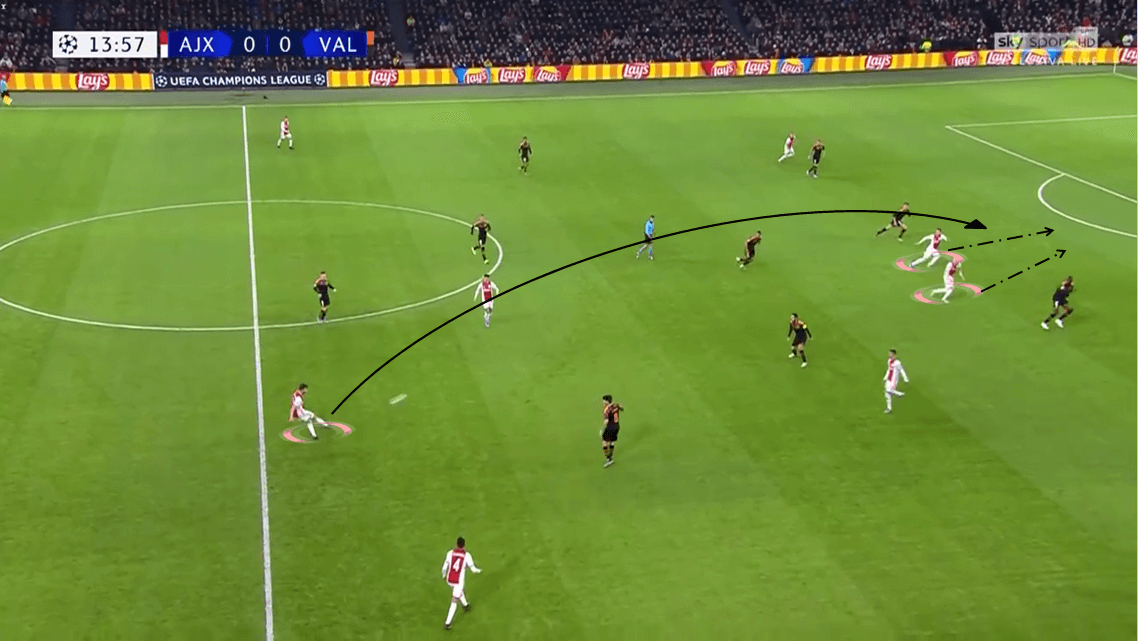
Defensively, they set up in a 4-2-3-1 formation that could also be seen as a 4-1-4-1 since Martínez occasionally roamed from his position to join up with the attacking midfielders and formed the midfield line of four. However, with them defending quite narrowly and opted to swarm the central area more often, this left quite a significant gap out wide for Valencia full-backs to overlap into. Thus, the centre-backs were able to make penetrative passes into the area and allowed the team to focus more on attacking down both flanks.
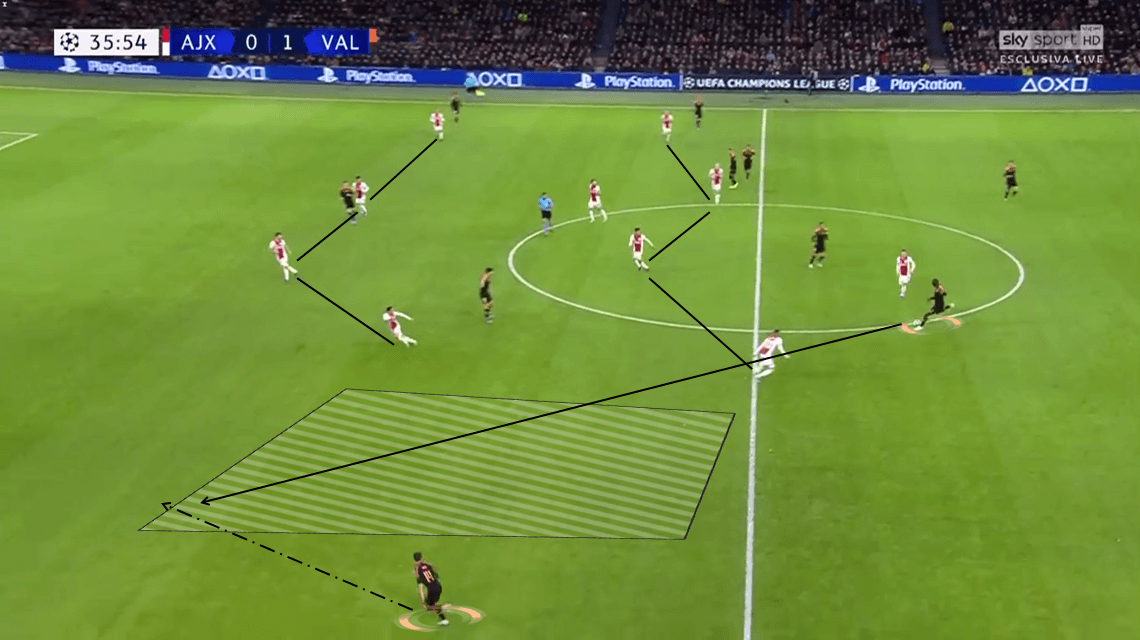
Conclusion
Before the match, many had thought Ajax would secure a spot in the knockout round with a positive result. Since they had the home advantage and being the leader of the group, recreating last year’s fairytale seemed to be in everyone’s mind. Meanwhile, Valencia travelled to the Netherlands knowing that nothing was acceptable besides three points. With a stubborn defensive strategy along with the ability to seize the crucial moment, the Spanish side got what they wanted and qualified for the next round in style as they finished top of the group.
For Ajax, from being the favourite for qualifying to the next round, to focusing on their campaign in the Europa League. Things changed so quickly for them given that they had enjoyed a remarkable journey last season that saw them made it into the semi-final. Nonetheless, it is important that they keep their heads held high and conquering the competition that last saw them lost in the final to Manchester United two years ago.

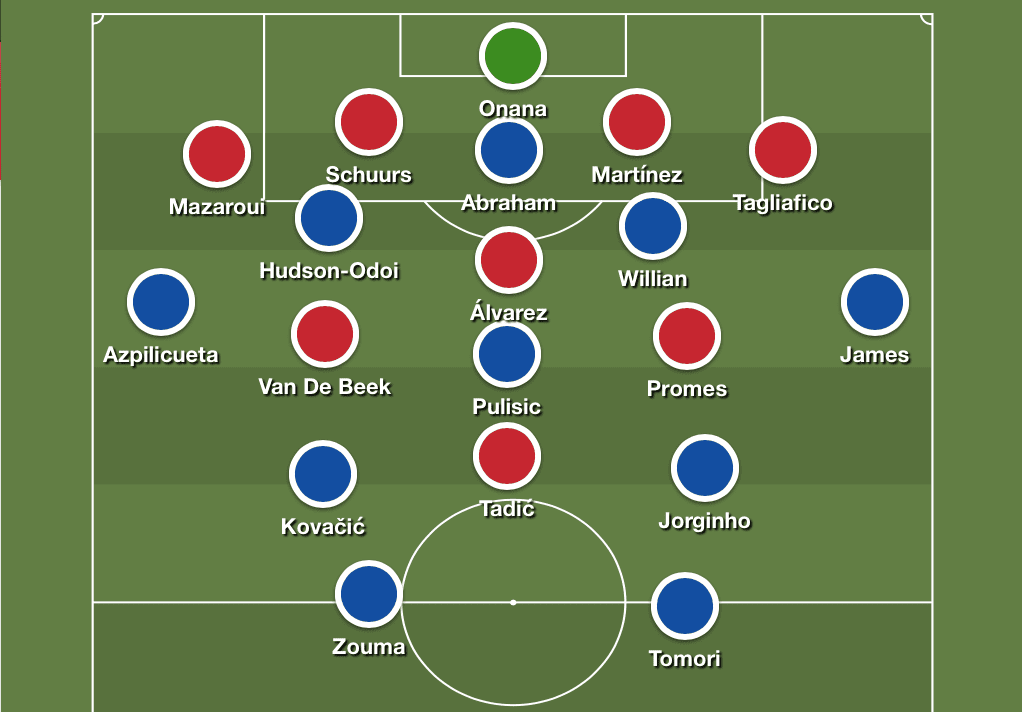



Comments